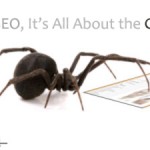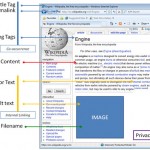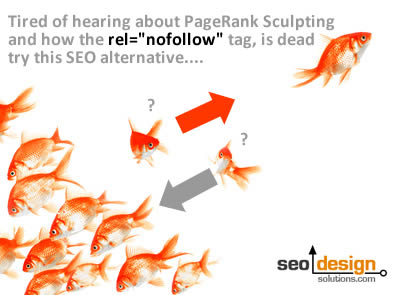In case you are searching for SEO alternatives for the rel=”nofollow” tag to sculpt page rank, at the end of this post there are links and suggestions for an old school work around. But first, an overview of Page Rank Sculpting…
Page Rank Sculpting Overview:
Over time the links you use as anchors become prominent as each page in your website takes on more authority. Not only are links just a way from getting from point A to point B within a website, but they also inherently hold the keys to search engine rankings as search engines use links and anchor text to assess relevance.
Search engines crawl links (within your website) to determine context and align the on page data (what the page is about) to other pages in the site and off page data (what other sites say about your pages).
Sometimes, by using the same links consistently across large areas of a website (such as navigation or a sidebar or template), you unintentionally diffuse the topic of the context or context of that segment. Page rank sculpting allows you to minimize the negative impact or hemorrhaging link flow, while consolidating the most significant links from the most significant sources within your website.
The Dilemma: Structuring Which Links Pass Value
The reason why the no-follow tag became popular was for sites linking out to others, the no-follow tag suppresses link flow from leaving the site providing the link to the site being linked to (in case you do not care to vouch for them or let them rank off your domain authority).
Seeing the benefits of this, some SEO’s began using the no-follow tag to sculpt the way that Google’s crawlers sifted through their pages. The premise was that by adding a no-follow tag to a link that it would become invisible to the crawlers and then proportionately provide more link juice to the remaining links on the page, this is page rank sculpting.
Much to the dismay of SEO’s (who were possibly some of the only people using no-follow to begin with), Google changed the way they processed the no-follow tag and suggested that instead of the link being invisible and the remaining link flow going to other links (which the link flow from the link) in the no-follow tag simply evaporated.
As a result, those who used the tag internally essentially have disrupted their own internal link graph not to mention could incur dips in rankings due to the amount of trust moving from page to page being diminished.
Now, for the Technique
As promised, here is the link to an “old school” advanced SEO technique hailing from the, pre-nofollow tag” era. In addition to using javascript links (which are now crawled from search engines), here is one no-follow alternative that you can employ in minutes courtesy of renowned SEO expert Charles Hefflin from SEO2020.com.
For those unfamiliar with the technique, the no-follow tag is a tag you can implement within the html code that allows a website to “link out to others” and not incur one of two things (1) theme diffusion or (2) a potential penalty from Google.
This tactic uses a minor modification to your robots.txt file and /cgi-bin/ directory and redirects links from a /cgi-bin/ script that elects to block spiders from crawling from the robots.txt via an exclusion command like the one noted below as an example.
User-agent: *
Disallow: /folder/
This is one of many techniques you could employ, but this one is quick, effective and preserves the link equity you have within your own website.
In the event you are curious to what the reference is for theme bleeding (it is covered in Charles’s post), or you can refer to our post on theme density and theming and siloing for a larger overview as an effective alternative to using flat site architecture (keeping all files in the root folder vs. subfolders segmented by topic) for search engine optimization.
Hat tip once again to Charles Hefflin on this priceless SEO technique that places the power of “page rank sculpting” back in the hands of webmasters who can appreciate the simple beauty and impact of this effective on page SEO technique. That is of course, if you elect to use it…











This works on the assumption that PR only flows down links that can be resolved to an accessible URL by bots – is this accurate?
The principle behind no-follow was a direct command to not pass any PR (link juice, link flow call it whatever) to the target URL. Note that this can be evaluated on a per URL basis i.e. parse HTML, establish link count, remove those that have rel=”no-follow” from total equite flowing URL count.
Conversly, using robots.txt and a redirect script means that Google must have knowledge of the accessibility of the target URL to decide if it should flow equity. I see this as distinguisable from no-follow as just because Google is blocked from spidering content, that doesnt change the intent of the link provided, and therefore may not prevent equity flow.
An analogy – do 404 pages acrue link juice? Do links to 404 URLs deplete link juice?
I’ve no answers to any of this, just thoughts.
I would have thought that if you want Google to ignore a link, you’re far better off putting it in a format that means it’s not contained within an tag, or so that it doesn’t appear for Google (regardless of how you achieve this, IP delivery, simple javascript cloak etc).
Cheers,
Steve
Steve, the predication is correct.
Sculpting in this connotation would imply that indexing is already accomplished, or anticipated from bots and this technique is a way to reduce the crawled links from the total volume of link equity.
Yet, since the bots cannot parse the script the target is null (under this premise).
I like the analogy to 404 pages as well, It’s hard to tell how broken links are treated for link equity…I think it’s time to experiment a bit and that would be an excellent test.
Thanks for the thought-provoking comment, equally as significant as the method gleaned above and worth investigating…
All the best Steve
Nice piece of information
Can you give me more idea about pagerank sculpting.
I think at this point, people are going to test, test, test on beta sites and keep their mouths closed so new of effective techniques don’t fall prey to the same critique…
Definately lots to learn – I agree with the test test test mantra. My only slight problem is that there are so many variables no test can ever be 100% accurate. Still worth a play.
Steve
Further to our discussion above Jeffrey – this came out today.
http://www.youtube.com/GoogleWebmasterHelp#play/all/uploads-all/0/TkopkUPF-M8
I’d like to think we inspired it, but somehow I’m not so sure :-)
i think you are missing a crucial part of the june 15th announcement. it doesnt matter if the link flows thru a redirect scrip residing in a dir blocked using robots.txt. if google sees the link, you are dividing up the link juice you pass to the other (dofollow) links on that page.
google these days also sees links in simple JS. so aside from fancier JS, you can only sculpt if put the links you dont want google to see in
a) iframes
b) flash (dynamic 1.x delivery to ensure google doesnt see it)
c) java
User-agent: *\
Disallow: /folder/
Real smart this is no different then the folder not existing the spiders will now not index or rank folder this is a NO genius approach..
Stupid stupid stupid…..
IFRAME Now your Thinking…
User-agent: *
Disallow: /folder/
was only implied for the CGI-Bin folder, IFrames are not tangible solutions.
You can easily just use on page anchors as well such as http://www.website.com/page.html#nested-link
Let’s not make things too complex.
Trying to sum up as an ignoramus, is it the overall view that the following all still work:
a) iframes
b) flash (dynamic 1.x delivery to ensure google doesnt see it)
c) java
d) and NOFOLLOW
@Eustache:
Although my first inclination is to say “yes and or some degree”, however based on the reality that each circumstance is truly unique.
What that degree is or where each is applicable depends on the ultimate objective.
In my honest opinion, I think this has to go back to the drawing board and time to test, test and retest before making statements.
Great volley, but there is always more than one way to skin a cat.
I know how to solve the issue though. ,
Hi there!
Its a great article, thanks for sharing.
But i am still a bit confused.
Actually i am trying to nofollow a particular link (say example.com) but not with a nofollow link, i am thinking of to do this by robots.txt.
So is this possible to nofollow any particular link by robots.txt??
I think this feature has created a lot of confusion. But if the whole idea of no follow is conceptually clear then it will definitely boost your site’s ranking
Still mess with Disallow directives for those pages where we want to obtained a nofollow sculpting benefit among some followed links, but disallow deindex and decrwaled the actual page instead of just treating nofollow …